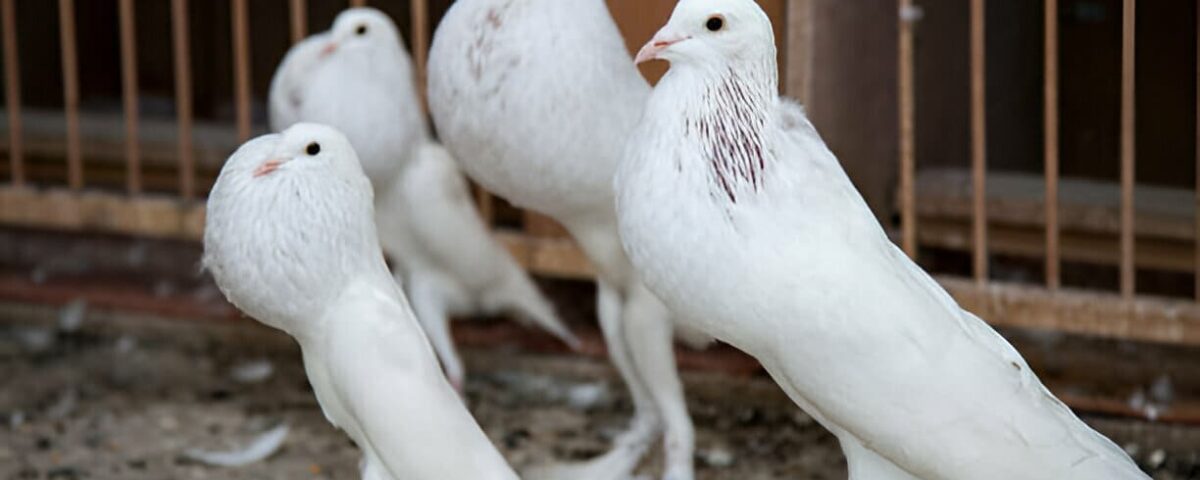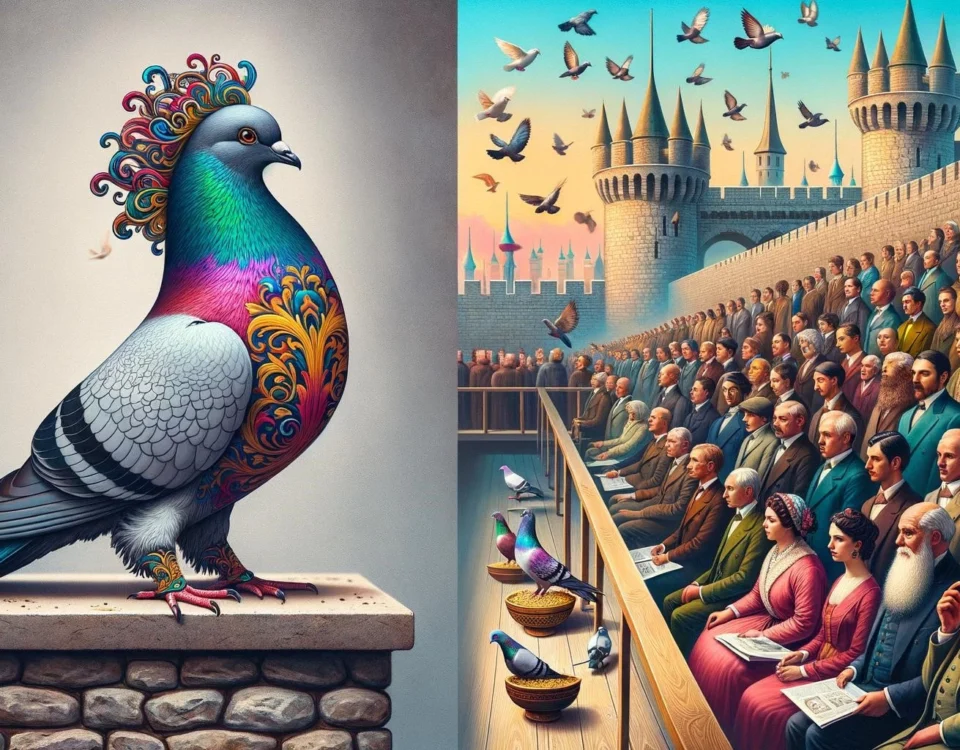
Valencian Homer
31/03/2024
Pigeon Lifespan: Understanding Lifespan in Various Environments
16/01/2025Introduction to Pouter Pigeons
Pouter pigeons, or Columba livia as they’re scientifically called, are a remarkable group of domesticated birds. Known for their striking inflatable crop, these avian beauties fall under the ornamental and fancy breed categories. Their unique appearance has been crafted through selective breeding, making them a favorite among pigeon aficionados.
What truly distinguishes pouter pigeons is their sizable, inflatable crop. This characteristic not only adds to their eye-catching look but also boosts their allure in shows and competitions. Although various types of pouter pigeons may differ in looks, the prominent crop is a universal feature across all breeds.
These fascinating birds have a rich history spanning over 400 years in Europe. While the specifics of their origins remain somewhat mysterious, they have been carefully bred over centuries to enhance traits like the size and form of their crop. This enduring tradition has given rise to numerous distinct varieties that continue to captivate breeders worldwide.
Pouter pigeons hold significant cultural value and are often showcased in exhibitions where they display their extraordinary features. Their presence enriches pigeon clubs and societies that strive to preserve these exceptional breeds. In essence, pouter pigeons embody both historical significance and aesthetic appeal within the bird community.
What Are Pouter Pigeons?
Pouter pigeons are domesticated birds recognized for their impressive, inflatable crops. These birds belong to ornamental and fancy breed categories and are cherished for their distinctive appearance. The crop not only adds to their visual appeal but also boosts their exhibition value. Though they descended from rock doves, pouter pigeons have been bred in Europe for more than four centuries, with their precise origins still unknown. There are several types of pouters, each sporting its own unique look, yet all are united by the captivating feature of a prominent crop that makes this breed so fascinating.
Distinctive Characteristics of Pouter Pigeons
Pouter pigeons are renowned for their distinctive traits, particularly their large, inflatable crops. This fascinating ability to expand their crops sets them apart from other pigeon varieties and enhances their decorative appeal.
Classified as fancy breeds, these birds are highly prized by pigeon enthusiasts due to their striking appearance. In addition to their looks, pouter pigeons possess a more robust build compared to other breeds, which contributes to their serene temperament—ideal for exhibitions where both aesthetics and demeanor are crucial.
All pouter pigeon types share this unique crop characteristic, underscoring its importance in both breeding and competition standards. Their blend of ornamental allure and gentle disposition has made them a beloved choice at bird shows and among hobbyists globally.
History and Breeding of Pouter Pigeons
For more than 400 years, Europe has been home to the breeding of pouter pigeons, a practice that began predominantly in England. Breeders concentrated on developing particular characteristics, notably the prominent inflatable crops. This intentional selection process produced numerous pouter varieties, each distinct yet unified by their remarkable crop feature. Among the most renowned breeds stemming from this tradition are the English Pouter and Dutch Pouter. While their precise beginnings are somewhat mysterious, these birds captivate pigeon enthusiasts with their unique appearance and personality traits.
Breeding History in Europe
Breeding pouter pigeons in Europe boasts a rich and intriguing history spanning over four centuries. This practice took root primarily in England, where breeders focused on accentuating characteristics like the birds’ remarkable inflatable crops. By practicing selective breeding, they created different varieties, including the renowned English Pouter and Dutch Pouter. While the origins of these pigeons are somewhat enigmatic, their distinctive appearance and charming personalities have captivated enthusiasts. Their lasting presence across Europe underscores a dedication to preserving their aesthetic allure while consistently enhancing their traits through meticulous breeding techniques.
Selective Breeding and Crossbreeding Experiments
Selective breeding and crossbreeding have been instrumental in shaping today’s Pouter pigeon. Through selective breeding, traits such as crop sizebody shape, and overall health are enhanced. Breeders meticulously select pairs for their genetic compatibility to produce offspring that align with breed standards. In contrast, crossbreeding enriches the gene pool, leading to new varieties with distinctive attributes. Together, these techniques ensure Pouter pigeons continue to evolve, maintain their appeal in shows and competitions, and keep their unique characteristics intact.
Influence of Charles Darwin on Pouter Pigeons
Charles Darwin made a significant impact on the study of pouter pigeons through his crossbreeding experiments in the mid-1800s. He began by acquiring his initial pairs of pouters in 1855 and used them, alongside other breeds such as Fantails, to explore genetic variations. Darwin’s goal was to grasp how selective breeding influenced physical characteristics.
- english Pouters possessed wider ribs,
- more vertebrae compared to other pigeon varieties,
- this discovery underscored the consequences of selecting specific traits for breeding purposes.
His research contributed to advancing our understanding of natural selection and hereditary features in domesticated animals.
Varieties of Pouter Pigeons
Pouter pigeons are a fascinating group, each type boasting its own distinct characteristics but all famous for their prominent crops. Among the favorites are:
- english Pouter,
- norwich Cropper,
- pygmy Pouter.
The English Pouter stands out at shows with its elongated body and impressive height. On the other hand, the Norwich Cropper captivates with its compact form and vibrant colors. The Pygmy Pouter may be smaller in size, yet it’s admired for its graceful shape and unique crop.
Beyond these popular varieties, there are several other intriguing types:
- brunner Pouter known for its streamlined physique,
- dutch Cropper celebrated for its robust build,
- elster Cropper with glossy feathers,
- gaditano Pouter appreciated for its rounded shape,
- ghent Cropper impresses with a sturdy appearance,
- granadino Pouter features an elegant long neck,
- holle Cropper recognized by its distinctive tail.
Together, these breeds contribute to the rich diversity of pouter pigeons through their individual traits while sharing their characteristic large crop feature. They captivate enthusiasts who revel in pigeon breeding and competitions where aspects like size and color take center stage in judging criteria.
Popular Varieties: English Pouter, Norwich Cropper, Pygmy Pouter
The English Pouter grabs attention at pigeon shows with its tall, slender stature and strikingly large, inflatable crop. Meanwhile, the Norwich Cropper distinguishes itself with a compact build and vivid colors that captivate both breeders and fans. Despite its smaller size, the Pygmy Pouter charms with its graceful form and distinctive crop. These diverse pouter pigeons highlight a range of features yet all share the striking characteristic of a prominent crop, which fascinates both breeders and judges at shows.
Unique Traits and Body Shape
Pouter pigeons stand out due to their unique characteristics and remarkable body shape. These birds are easily recognizable by their hefty bodies and short legs. The English Pouter is particularly renowned for its tall frame and feathered legs, traits that have been refined through selective breeding over the years.
Breeders aim to enhance features such as the size and shape of the pigeon’s inflatable crop, a signature trait across all pouter varieties. This feature not only catches the eye but also plays a crucial role in competitions.
There is considerable variety among pouters when it comes to body shapes. For instance, while the English Pouter boasts a long, elegant body, breeds like the Norwich Cropper or Pygmy Pouter are more compact. Each type captivates pigeon enthusiasts with its distinct qualities.
Beyond their physical attributes, pouter pigeons are admired for their gentle temperament, adding to their ornamental appeal. This combination of striking appearance and calm demeanor makes them highly prized at bird shows where judges assess both looks and behavior.
Color and Size Variations
Pouter pigeons exhibit a fascinating diversity of colors and sizes, a result of careful selective breeding. Breeders focus on enhancing specific traits to align with the standards admired by pigeon enthusiasts and competition judges. These birds display an array of hues, including:
- blue,
- red,
- black,
- white.
Their feathers often feature elaborate patterns, such as pied or mottled designs.
The size variations among these pigeons are equally remarkable. For example, the English Pouter is known for its impressive height due to its elongated body, whereas the Pygmy Pouter remains more compact while maintaining essential breed characteristics. These differences in size and color not only amplify their beauty but also increase their attractiveness at shows where appearance holds significant importance. By understanding these attributes, breeders can better meet show criteria and enhance the ornamental allure of their collections.
Care and Maintenance of Pouter Pigeons
Pouter pigeons thrive when given specific attention, primarily through a spacious and clean living environment. It is crucial that their habitat is well-ventilated yet free from drafts to maintain their health. Regularly tidying up the loft prevents waste accumulation and reduces the risk of illness. Providing perches and nesting materials enhances their comfort.
A balanced diet is fundamental for their well-being. It consists of a blend of seeds, grains, and fresh vegetables to supply essential nutrients. Ensuring access to fresh water at all times keeps them properly hydrated.
Exercise plays an equally vital role for these birds. Having a secure area where they can fly helps maintain fitness and boosts overall health. Routine veterinary check-ups are essential to detect any potential issues early, contributing to the long-term care of pouter pigeons.
Specific Care and Feeding Requirements
A balanced diet is vital for the well-being of Pouter pigeons. They require:
- variety of grains,
- seeds,
- fresh vegetables to obtain necessary nutrients.
It’s also important to ensure they always have access to clean water for proper hydration. Maintaining cleanliness in their living environment helps ward off diseases and promotes good health. Regularly tidying up their loft and supplying suitable perches along with nesting materials can enhance their comfort. Additionally, allowing them ample exercise in a secure area contributes significantly to their fitness and overall wellness.
Breeding Practices and Techniques
Breeding Pouter pigeons requires attention to attributes such as crop sizebody shape, and overall health. Breeders carefully choose pairs with compatible genetics to align with breed standards. This meticulous selection process ensures the preservation of desired characteristics while reducing the risk of genetic issues.
Creating a balanced environment is vital for breeding pairs to thrive. Proper housing conditions enhance their well-being, while cleanliness and good nutrition are essential for the health of adult pigeons and their chicks.
Frequent observation during the breeding period allows breeders to detect any potential health problems early on. They may also use artificial lighting to replicate natural environments, which can support successful mating cycles. By employing these comprehensive methods, breeders can raise high-quality Pouter pigeons that are both healthy and visually appealing for exhibitions and competitions.
Maintaining a Pigeon Loft
Maintaining a tidy and organized pigeon loft is crucial for the well-being of Pouter pigeons. Adequate ventilation and ample space contribute to a cozy environment. Regular cleaning is vital, as it minimizes waste accumulation, thereby preventing disease. Access to fresh air and plenty of sunlight further enhances their health. Additionally, offering nesting materials and perches boosts comfort, making the loft an ideal sanctuary for these ornamental birds.
Pouter Pigeons in Shows and Competitions
Pouter pigeons steal the spotlight at shows and competitions, thanks to their unique characteristics. These gatherings provide breeders and enthusiasts with the perfect opportunity to showcase the pigeons’ striking beauty, particularly their impressive inflatable crops. Judges assess these birds based on specific criteria that emphasize physical attributes such as:
- size,
- posture,
- feather quality.
By participating in these contests, breeders gain recognition for refining the breed’s appearance through meticulous selection. It also fosters a sense of community among pigeon lovers who are passionate about enhancing these decorative birds. Preparing pouter pigeons for such events requires dedication and attention to detail to ensure they meet the high standards expected at fancy pigeon exhibits.
Role of Pouter Pigeons in Fancy Pigeon Exhibits
Pouter pigeons shine in fancy pigeon shows due to their distinctive characteristics and striking beauty. Their most notable feature, the inflatable crop, draws attention from both judges and onlookers alike. In these events, breeders have the opportunity to showcase their pigeons’ elegance and vie for accolades based on attributes such as size, posture, and feather quality. Including pouter pigeons in these exhibitions adds variety, offering enthusiasts a chance to admire the diverse appearances within this breed. Additionally, these gatherings foster a sense of community among pigeon aficionados who are dedicated to preserving and enhancing these ornamental birds.
Participation in Pigeon Shows and Competitions
Participating in pigeon shows and competitions allows Pouter pigeon enthusiasts to exhibit their birds’ distinctive characteristics. These events provide breeders with the opportunity to emphasize their pigeons’ quality, particularly unique features like the inflatable crop. Judges assess the birds based on various criteria, including size, posture, and feather quality.
Engaging in such shows not only helps breeders gain recognition but also fosters camaraderie among pigeon hobbyists. Exchanging breeding techniques and insights at these gatherings enriches the community’s shared knowledge. For regular attendees, these events are invaluable for connecting with fellow enthusiasts and promoting high standards within the pigeon-keeping hobby.
Judging Criteria and Show Standards
In pigeon shows and competitions, judges concentrate on particular traits that align with the breed standards for pouter pigeons. They pay special attention to:
- the size of the crop,
- the bird’s appearance,
- body shape and proportions.
The pigeon’s overall health is paramount. Judges expect vibrant feathers and alert behavior, indicating good care from breeders. These standards ensure that only pigeons in excellent condition and with superior looks receive recognition in competitions.
Show guidelines define the ideal characteristics each breed of croppers should possess. This assists breeders in selecting their birds wisely to increase their chances of success at exhibitions. By adhering to these standards, breeders contribute to maintaining and enhancing the ornamental allure of pouter pigeons.
Pouter Pigeon Clubs and Societies
Pouter pigeon clubs and societies play a crucial role in preserving and promoting this distinctive breed. The National Pouter and Cropper Club, for instance, is dedicated to these pigeons, providing invaluable resources to both breeders and enthusiasts. It emphasizes the importance of sharing knowledge on breeding techniquescare requirements, and participating in competitions. This commitment helps uphold high standards within the pouter pigeon community.
In addition to national efforts, regional groups like the Victorian Pigeon Clubs and the Pigeon Fancier Society are also significant contributors. They offer platforms for members to share insights and celebrate their love for pigeons. These societies not only support breeding initiatives but also ensure that heritage and traditional standards are passed down through generations.
Collectively, these clubs foster a community where pigeon fanciers can connect, learn from each other, and hone their skills in raising pouter pigeons. By organizing events where members showcase their birds’ unique characteristics, they strengthen bonds among enthusiasts while enhancing appreciation for these ornamental breeds.
National Pouter and Cropper Club
The National Pouter and Cropper Club serves as a vital hub for pigeon enthusiasts, especially those passionate about pouter pigeons. Its mission is to promote and preserve the unique characteristics of these birds by offering valuable resources on breeding techniques and essential care practices. The club provides comprehensive information about competitions, equipping members with the necessary knowledge to uphold high standards in the pigeon community. Moreover, it hosts events and shows that unite breeders, giving them opportunities to showcase their birds’ extraordinary traits and exchange insights within this specialized realm.
Victorian Pigeon Clubs and Pigeon Fancier Society
Victorian Pigeon Clubs and the Pigeon Fancier Society play a vital role in the pigeon enthusiast community, especially for those passionate about breeds like pouter pigeons. These groups offer platforms for members to exchange knowledge, participate in events, and advocate for different pigeon varieties.
- they are crucial in maintaining the heritage and standards of pigeon breeding,
- through organizing various gatherings, these clubs foster connections among fanciers,
- promoting the exchange of insights into breeding techniques and care practices.
This collaboration safeguards traditional values while embracing contemporary advancements in pigeon-keeping.
National Pigeon Association and British Homing World Show
The National Pigeon Association and the British Homing World Show are vital occasions for those passionate about pigeons. These events offer breeders, particularly those focused on pouter pigeons, a chance to meet and compete. The National Pigeon Association is crucial in setting breeding standards and offers educational materials for pigeon lovers.
On the other hand, the British Homing World Show serves as an esteemed venue to highlight pigeons’ distinctive traits and cultivates a sense of camaraderie among attendees. Together, both events significantly contribute to preserving the diverse heritage of numerous pigeon breeds.



